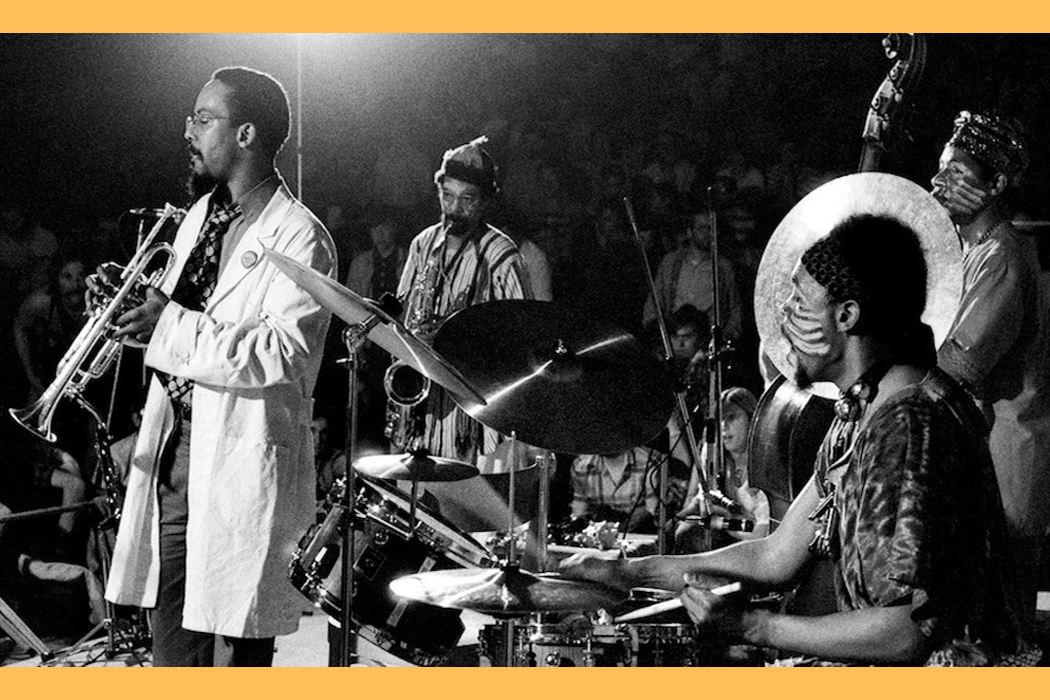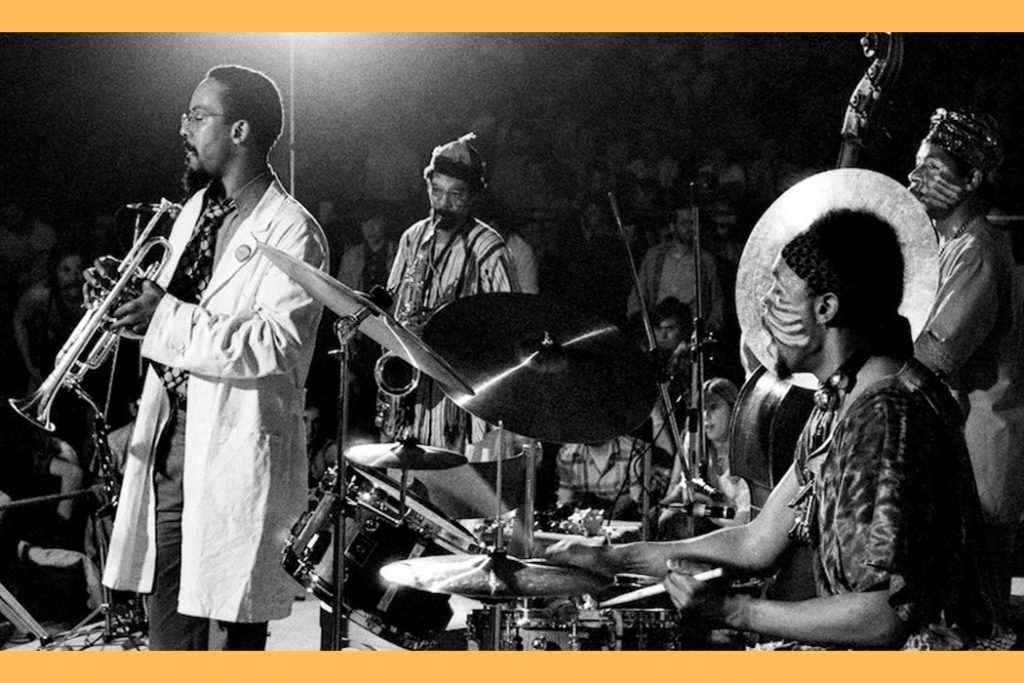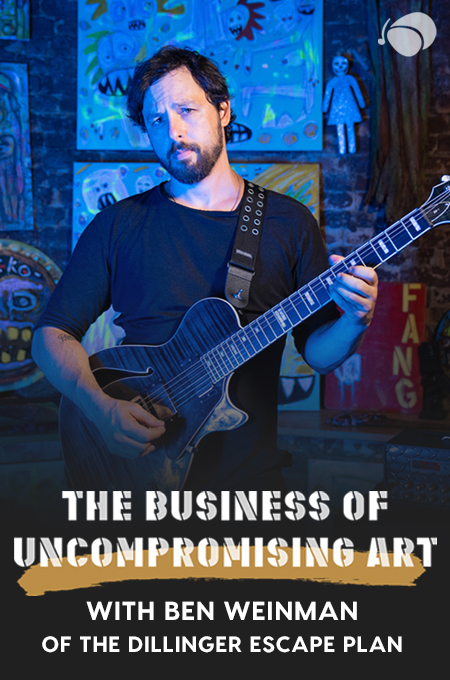
+ Bridge the worlds of theory, improvisation, and jazzy hip-hop, and improve your piano chops with Grammy-winner Kiefer in his course, Kiefer: Keys, Chords, & Beats.
For the musicians of the many houses of improvised music out there, the Art Ensemble of Chicago is one of the most influential bands of the 20th century. Yet for those not in the know, it’s hard to chart their importance in the way that jazz and avant-garde music developed in the latter part of the century. While I hope to introduce and demystify this powerhouse group, there is no simple answer to the question, “who is the Art Ensemble of Chicago.”
So let this be a humble introduction. If this music sings to you, as it does to me, I encourage you to dive in and explore their discography and legacy more deeply.
The Art Ensemble of Chicago is a collective of musicians who operate under the motto “Great Black Music: Ancient to the Future.” For many years the group consisted of saxophonist Roscoe Mitchell, trumpeter Lester Bowie, saxophonist Joseph Jarman, drummer Don Moye, and bassist Malachi Favors; though the group continues to exist today with Mitchell and Moye leading, along with a rotating cast of side musicians.
While the band is generally considered to exist within the jazz tradition, one of their hallmark characteristics is that their sound cannot be pinned to a specific genre or style. Rather, the Art Ensemble seems to embody creative sonic exploration, and their music encompasses modern composition, African drumming, funk and soul songs, theatrical presentation, and much more. And all of the musicians share compositional duties.
It’s difficult to understand the Art Ensemble of Chicago and its motives without understanding the Association for the Advancement of Creative Musicians (AACM), a musical collective that formed in the south side of Chicago in 1965 and functioned as a catalyst for many historic groups in creative music, as a concert promoting organization, and also as a long-running music school that fostered the growth of the city’s music community.
To get deeper into the AACM, its work, and its historical importance and context, I strongly advise you check out George Lewis’ excellent and thorough history of the organization, A Power Stronger Than Itself: The AACM and American Experimental Music.

The Art Ensemble of Chicago was one of the first groups to grow out of the early AACM, in many ways leading the pack of creative musicians that would follow in their footsteps, including Anthony Braxton, Henry Threadgill, George Lewis, and Muhal Richard Abrams — all of whom would go on to lead fruitful and influential careers and pioneer new languages of jazz in their own singular ways.
In 1966, Roscoe Mitchell, one of the early members of the AACM, recorded and released his record, Sound, featuring a sextet that included trumpeter Lester Bowie and bassist Malachi Favors. In 1968, Mitchell released the album, Conglipitous, under the name The Roscoe Mitchell Art Ensemble, featuring Bowie and Favors, as well as drummer Robert Crowder.
By 1969, the group had mostly relocated to Paris as a quartet, now including saxophonist Joseph Jarman. Don Moye joined in 1970 and that basically cemented the most consistent lineup of the group for years to come. It’s worth mentioning that the jazz connection between Chicago and Paris has always been strong, and remains so today with transatlantically-based musicians frequently collaborating on trips overseas. In Paris, a promoter billed Mitchell’s group as “The Art Ensemble of Chicago,” mostly for descriptive accuracy, and they decided to keep that as the official name of the ensemble from then on.
Bowie and Favors have since passed away, but Mitchell and Moye continue to tour with a version of the group today. The AEC recorded for local labels in Chicago (Delmark), in Paris (Pathé, BYG, Saravah), in Japan (DIW), as well as internationally distributed labels like ECM and Atlantic.
George Lewis does an excellent job of explaining the essence of the Art Ensemble’s sound in his book with this succinct description:
“The group’s unusual hybrid of energy, multi-instrumentalism, humor, silence, found sounds and homemade instruments — and most crucially, extended collective improvisation instead of heroic individual solos — proved revelatory to European audiences.”
There are many places to go to listen for these elements — their discography is vast, and citing classic records like A Jackson in Your House, People in Sorrow, Message to Our Folks, Certain Blacks, Chi Congo, and Les stances à Sophie, only serves to scratch the surface.
There is so much visual and theatrical information at play in the AEC’s performances, that I think the quickest way to give a crash course in this iconic group is through live performance. Only once you’ve seen the band in action do the sounds on the records really begin to tell the bigger story of what is or what could be happening at any point in time. There’s a seriousness to the way they undertook their mission to tear down jazz tropes and standardized behaviors, but they managed to have so much fun doing it, that there’s also an undeniable goofiness to the music.
This theatricality and performative drama inherent to both their live shows and their recorded material, added a new dimension to the excitement of jazz music. In his book, George Lewis describes that drama by quoting a concert review where writer, Daniel Caux describes one of their early concerts:
“Listeners were surprised to see Joseph Jarman, his naked torso and his face painted, passing slowly through the aisles murmuring a poem while the bassist Malachi Favors, wearing a mask of terror, screamed curses at Lester Bowie, and Roscoe Mitchell operated various car horns.”
Possibly the most exciting quote featured in Lewis’ book is a description of an outlandish Art Ensemble performance taken from a 1975 Downbeat review:
“Bowie came out first, sporting a casino dealer’s visor on his head and drinking from a pint of whiskey. Jarman and Moye staggered across the club like two winos, holding each other for balance, shooting off streamers and mumbling nonsensically. Bowie spotted them and yelled, “Over here! None of this music shit, we’re gonna play cards!” Somehow they found their way to a table set up in front of the stage, where a deck of cards was produced. Bowie proceeded to deal furiously, cards flying everywhere, the three drinking and cursing each other in a hilarious parody of a seedy card game perhaps, or a parody of a jazz club.”
Evidently, anything was possible at one of these concerts!
The short documentary below provides a pretty solid introduction to the band. It has a few different live clips that highlight very different parts of the group’s sound from lowdown funk to free jazz to African drumming, and features some great quotes from the members.
Here’s another clip from a documentary with some really excellent footage, my favorite is the weird ragtime-themed section.
Here’s a live clip from 1983 that features a ripping high energy solo from Roscoe Mitchell after Moye concludes his percussive explosion and the band revisits the tune’s main theme. Notice Bowie’s seated trumpet stabs and accents until he jumps up and joins in the jam himself.
And here’s one of my favorite studio tracks by the band, “Theme De YoYo,” a catchy funk tune with excellent blasting free jazz breakdowns and the soulful singing of Fontella Bass.
Lastly, for a much deeper exploration into the band’s historic catalog, please head over to our friends at The Vinyl Factory to check out jazz journalist, Todd S. Jenkins’ piece “Afro Avant-Garde: The Essential Art Ensemble of Chicago in 10 Records.”
Don’t stop here!
Keep learning about theory and harmony, composing and arranging, songwriting, and more, with Soundfly’s in-depth online courses. Subscribe for access to all, including The Creative Power of Advanced Harmony, Orchestration for Strings, and our exciting new course with Grammy-winning pianist and producer, Kiefer: Keys, Chords, & Beats.




